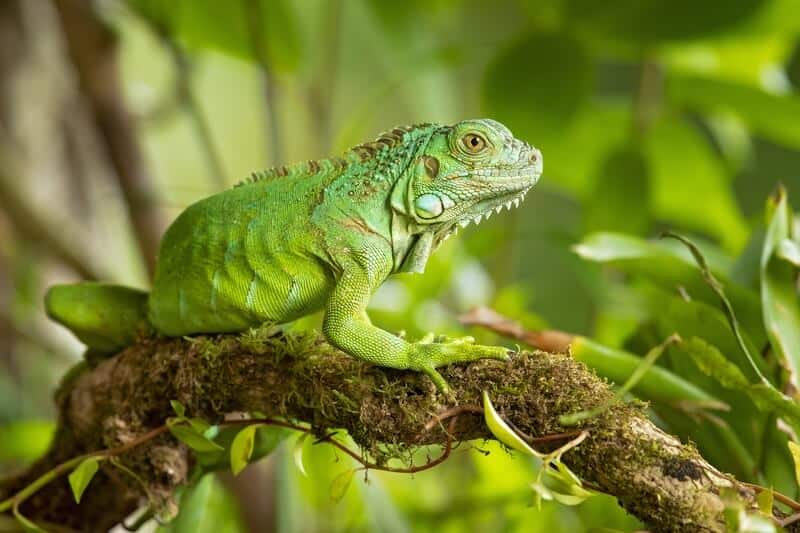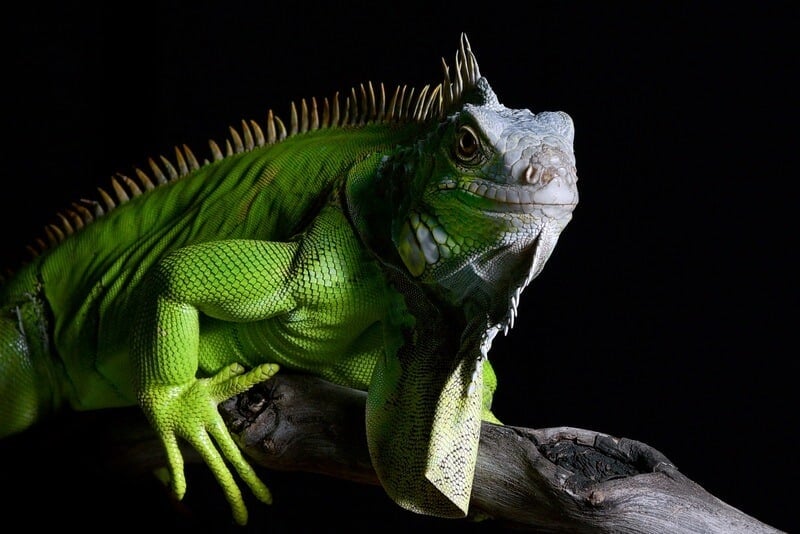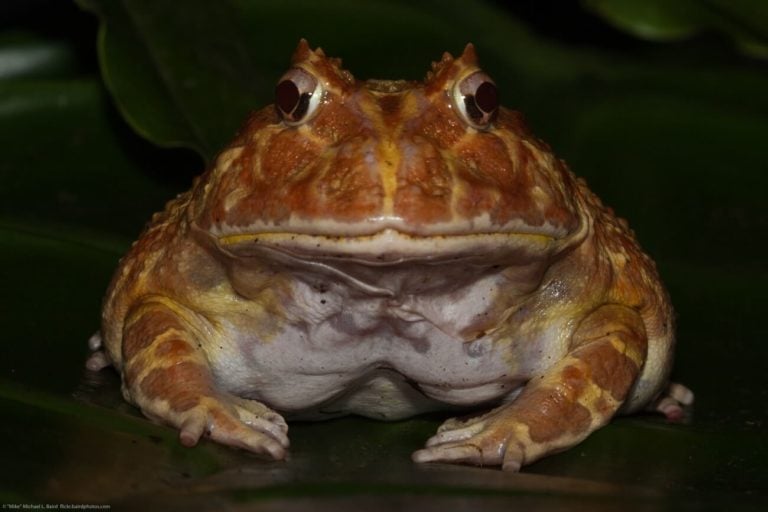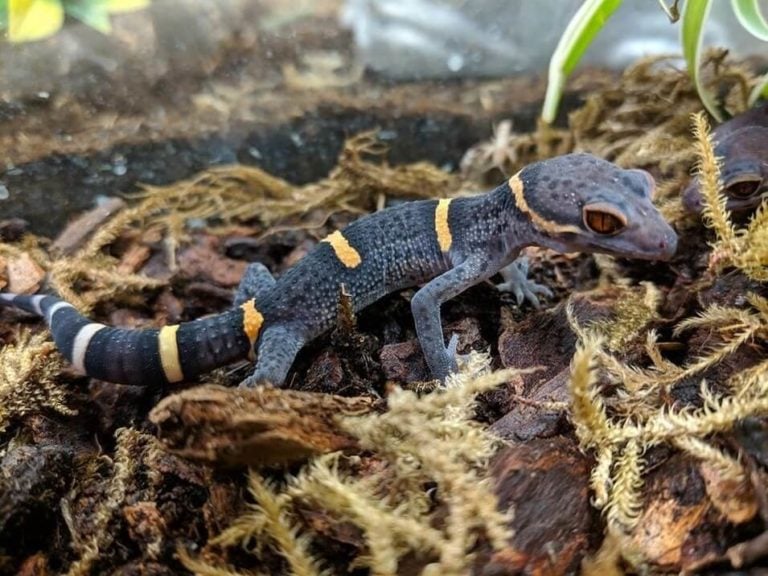Green iguanas are one of the most popular reptiles on the face of the planet, so it’s only natural that many people would be interested in owning one as a pet. But while these lizards are fairly easy to care for, there are certain things potential owners need to be aware of when it comes to keeping these reptiles in captivity.
This guide will cover everything you need to know about green iguana care. You’ll learn about their diet, habitat, size, lifespan, temperament, and many other interesting facts!
Table of Contents
Species Summary
Hailing from tropical jungles throughout North, South, and Central America, the green iguana (scientific name: Iguana iguana) is a popular species in the pet trade. Over a million wild-caught iguanas are imported into the United States annually. These lizards are also a favorite among breeders and collectors.
Known for their dinosaur-like appearance, green iguanas can be a joy to raise and keep as pets. They have quirky personalities and are known to form lasting bonds with owners. Pair that with their wide availability and willingness to adapt, and you have a lizard that’s perfect for life in domestication.

But like all exotic animal species, green iguanas have unique needs that many fail to consider. Unfortunately, many types of iguanas are often abandoned, resulting in invasive populations popping up in some parts of the world.
Even still, green iguanas remain one of the most popular lizard species in the trade. If you’re willing to put the work in, they can be a rewarding animal to care for.
Appearance & Colors
Green iguanas have an unmistakably prehistoric look. Most of their signature details are on the face and back.
The lizard’s core is girthy and robust. Four agile legs and clawed fingers help them climb trees gracefully. Meanwhile, their enormous tails provide balance and act as a defense weapon in the face of danger.
Lining the lateral line is a row of dorsal spines. They look pretty sharp to scare off predators, but they’re safe to touch. Underneath the chin is a sizable dewlap, which contributes to that dinosaur-like profile even more!
Expert Tip: This species does display sexual dimorphism, but the differences between males and females are subtle. Males tend to be a bit bigger than females. Plus, they have larger femoral pores and a more pronounced dewlap.
The green iguana species is complex. While herpetologists use that name collectively, there are many different varieties available. As you can guess, the rarer ones can come with a premium price tag due to the demand from collectors.
The “standard” green iguana features vibrant green coloration. Darker bands of green run horizontally down the tail. Many also have splotches of pale brown or gray to break up the green.
Other popular variants take on hues of red, blue, or white. Red iguanas feature accents of blood-red accompanied by a gray body.
Blue iguanas, also known as Axanthic iguanas, lack yellow pigment in their skin. As a result, they have almost baby-blue skin.
Albino iguanas are white, cream, or yellow. They lack dark pigmentation.
Average Green Iguana Size
Those who haven’t seen green iguanas in person sometimes underestimate their size. These aren’t small lizards!
The average green iguana size is six to seven feet in length for a full grown adult. Females are a little smaller, usually staying below the five-foot mark. But even then, they’re pretty large compared to other species in the trade.
When it comes to weight, healthy adults can tip the scales at around 20 pounds.
Lifespan
Green iguanas have a typical lifespan of 15 to 20 years in captivity. In rare cases, some iguanas reportedly pushed to 25 years old.
As always, life expectancy is a complex matter with no guarantees. Even with the best care, reptiles can sometimes suffer from sudden disease and early death.
All that said, the best way to increase the odds of a long and happy life for your lizard is to provide the best green iguana care that you can. Exceed their needs and regularly visit a vet specializing in exotic reptiles to ensure that your lizard is in good shape.
Green Iguana Care
Green iguana care isn’t particularly challenging. However, it’s not as straightforward as many novice reptile-keepers are led to believe. These lizards have many essential requirements you’ll need to meet.
Failing to meet them could cause undue stress, health issues, and many other problems. Luckily, it’s about having the right information.
Check out the green iguana care guidelines below to learn all you need to know.
Enclosure Size
Here’s where many inexperienced herpetology enthusiasts go wrong. Green iguanas need a sizable enclosure to stay happy, healthy, and comfortable.
A general rule of thumb is to provide a habitat at least twice as long as the iguana. With adults reaching six feet or more, you can see where the challenge lies!
Young juveniles can do fine in a 20-gallon terrarium. But, you’ll need to upgrade in about six months to something much bigger.
Adults will need an enclosure that’s approximately 12 feet long, six feet wide, and six feet tall! It’s impossible to find a habitat of that size made out of glass without doing a custom order. Because of this, most owners utilize a wire cage.
Expert Tip: Custom-built enclosures are pretty standard for adults, so if you’re not interested in navigating this process we recommend a smaller pet lizard species.
Setting Up Their Habitat
Once you have the enclosure set up, you’ll need to add plenty of decorations to make it enriching for your pet. Proper green iguana care requires you to be very conscious of their natural habitat.
Start by choosing a substrate material. An absorbent material is best, as you’ll need to maintain high humidity levels. More on that later.
Paper rabbit pellets, alfalfa pellets, and unscented wood mulch work fine. Commercial sand and soil mixtures are suitable as well. Green iguanas tend to use the bathroom in the same spot every day, so maintenance is pretty straightforward. Focus on selecting an absorbent and safe substrate material.
Next, add branches and platforms to create a network of climbing surfaces. Green iguanas are arboreal and spend a lot of time in trees. They’ll climb to their favorite basking spot and lay there for hours!
Get creative here and use a mix of vines, branches, and wood platforms to give your iguana plenty of options in how they want to climb.
On the surface, you can add some plants. Live plants are always preferred when possible, as green iguanas like to graze. One excellent plant choice is Hibiscus. These lizards love the stuff!
Expert Tip: If you add live plants, rinse the soil and quarantine them for about two weeks to avoid bringing anything into the habitat.
Temperature & Lighting
Green iguanas love warm weather, so you’ll need to use powerful lights to simulate their natural living conditions. These lizards have a unique “third eye.” Called the parietal eye, it enables thermoregulation. To ensure that this eye functions normally, you must install the lighting and heating elements overhead.
Do not use ceramic heaters or faux warming rocks. Green iguanas are notorious for burning themselves. Instead, use standard overhead lighting to establish and maintain a temperature gradient.
Here’s how you should set up the temperature in their habitat:
- On the cool end of the enclosure, temperatures should be around 75 to 80 degrees Fahrenheit.
- On the warmer side, aim for readings between 95 and 100 degrees.
- In one high corner of the enclosure, create a basking spot with a dedicated lamp. It should have temperatures of 115 to 120 degrees.
Expert Tip: Connect your lights to a timer. Green iguanas need a typical day and night cycle to stay healthy.
In addition to the standard lights, install full-spectrum UVB lights. The UV lights mimic the rays of the sun, which are essential for calcium synthesis.
The UV lamps are a crucial addition that many fail to install. Make sure that the entire enclosure is covered in UV light during the day. Otherwise, you might encounter some serious health complications.
Humidity
Between 60 and 70 percent humidity is a must. Green iguanas come from tropical and subtropical environments. High humidity levels are an essential part of green iguana care, so you should aim to replicate their natural habitat as much as possible.
Install a hygrometer and check on it regularly. If you need to raise the humidity level, mist the enclosure. The plants and absorbent substrate will help to keep things stable.
Expert Tip: If you want to automate things, consider installing a mister system. It’ll make sure that humidity levels are consistent no matter what.
Water
Green iguanas stay hydrated in many ways. They’ll sometimes lap up droplets of water on hibiscus plants, absorb moisture from the air, or soak their skin.
Either way, providing a clean dish of water is paramount. Don’t be surprised if you don’t see your lizard drinking from the water. There’s a good chance that they’ll use it in other ways.
Install a large, shallow container that’s big enough for the iguana to crawl into. Replenish the water daily and give it a good scrub anytime it gets messy. Iguanas often defecate in the water after soaking, so keep an eye on its cleanliness to keep bacteria under control.
For an extra boost of hydration, you can also try misting their food. The lizards will consume the water as they eat.
Green Iguana Food & Diet
The diet of green iguanas can present a challenge. These lizards need to eat once or twice a day, depending on the portion size. Not only that, but they require a wide variety of plant-based foods to get all the nutrients they need to stay healthy.
Green iguanas are herbivores that thrive on leafy greens. Most of their diet should consist of foods like:
- Collard greens
- Kale
- Mustard greens
- Turnip greens
- Romaine lettuce
- Dandelion greens
The following vegetables are great as well.
- Squash
- Green beans
- Squash
- Broccoli
- Zucchini
- Carrots
Provide a colorful salad for the broadest profile of nutrients. Make sure to cut everything into small, bite-sized pieces. Green iguanas aren’t the most vigorous chewers, so you’ll need to make the meals easy to consume.
Occasional fruit snacks are acceptable. However, make sure to limit those fruits to once or twice a week. Providing too much could result in diarrhea.
Avoid foods that don’t provide much in the way of nutritional value. For example, iceberg lettuce is a no-go. Steer clear of high-calcium greens like spinach and parsley, too. They can lead to calcium-binding.
Expert Tip: About once or twice a week, provide a calcium supplement. You can dust the meals in calcium powder, which is easy to consume and doesn’t affect the flavor of the food. For good measure, try adding general multivitamin supplements as well.
Potential Health Issues
Green iguana care is fairly straightforward, and these lizards aren’t at risk for any species-exclusive health complications. However, they can suffer from all the usual reptile ailments.
These lizards can experience issues like mouth rot, respiratory infections, and skin infections.
Mouth rot and respiratory inflammation are usually a direct result of poor environmental conditions. Inadequate temperature settings or low humidity can lead to all kinds of trouble, so make sure to maintain the habitat. Symptoms include discharge, swollen tissue in the mouth and throat, and open-mouth breathing.
Fortunately, these conditions are easy to treat with some antibiotics.
Skin infections can arise from bacteria or fungi. Bacteria in the enclosure is the worst offender. It can quickly cause disease and illness.
Green iguanas are pretty injury-prone due to the shape of their claws and climbing behavior. Minor cuts can turn into severe infections if the enclosure is rife with bacteria. Make sure to clean it regularly and sanitize every surface about once a month.
Conditions like egg retention and metabolic bone disease are common with green iguanas as well. Egg retention is when eggs get stuck in a female’s reproductive tract. Meanwhile, metabolic bone disease occurs when a lack of calcium weakens the skeletal system.
These two issues are a product of poor lighting and nutrition. No exposure to UV rays disrupts the calcium synthesis process, leading to bone problems and more. Once again, thorough maintenance and attention to detail are a must!
Keep up with your lizard’s habitat and dietary needs to ensure that they’re able to thrive and stay healthy.
Behavior & Temperament
Green iguanas are pretty easygoing. As adults, they prefer to live life in solitary.
Younger iguanas can live in groups. There, they’ll look after one another and even show active signs of protection in the face of danger. However, that social nature changes after the lizard reaches a year old.
They can become territorial. Males, in particular, can become aggressive towards one another. The males will also be rough around the breeding season, putting the females in danger.
It’s best to keep green iguanas on their own. Keeping two or more together will only cause undue stress.
When they feel threatened, green iguanas will exhibit all kinds of fiesty behavior. Not only do they hiss and try to escape at every opportunity, but they may also injure themselves. Stressed iguanas will rub their noses against the walls of the enclosure to the point of bleeding!
Luckily, it’s easy to avoid all those unwanted issues if you keep your iguana alone.
A happy and healthy green iguana will spend its day lounging around and basking in the light. They rarely spend any time on the ground, so make sure plenty of climbing surfaces are available.
Handling
Regular handling is possible. However, it requires slow socialization from a young age.
Green iguanas that have recently been introduced to a new home tend to be skittish and fearful. They might show signs of aggression. Attempting to handle them at this point is not wise. In addition to stiffening up their body, most iguanas will turn to self-defense to avoid it!
Green iguanas have sharp claws to scratch you with and powerful tails to whip back and forth. On top of all that, they have razor-sharp teeth. Bites do occur, and iguanas aren’t afraid to use every tool available when they feel threatened.
Avoid handling in the early stages of ownership. Give your lizard plenty of space. Try moving items in the enclosure around and feeding your iguana by hand.
Eventually, they’ll start to trust you. Once you get to that stage, you can gently handle your iguana for a few minutes at a time.
When you do, point their face away from yours and use your hands to support the body. Be gentle and avoid sudden movements to keep the peace.
Conclusion
Green iguana care is something that pretty much any owner can manage. However, you need to be aware of their size and the challenges it brings.
As long as you’re prepared for this, we recommend these pet reptiles to anyone. They’re fun, rewarding, and beautiful!



